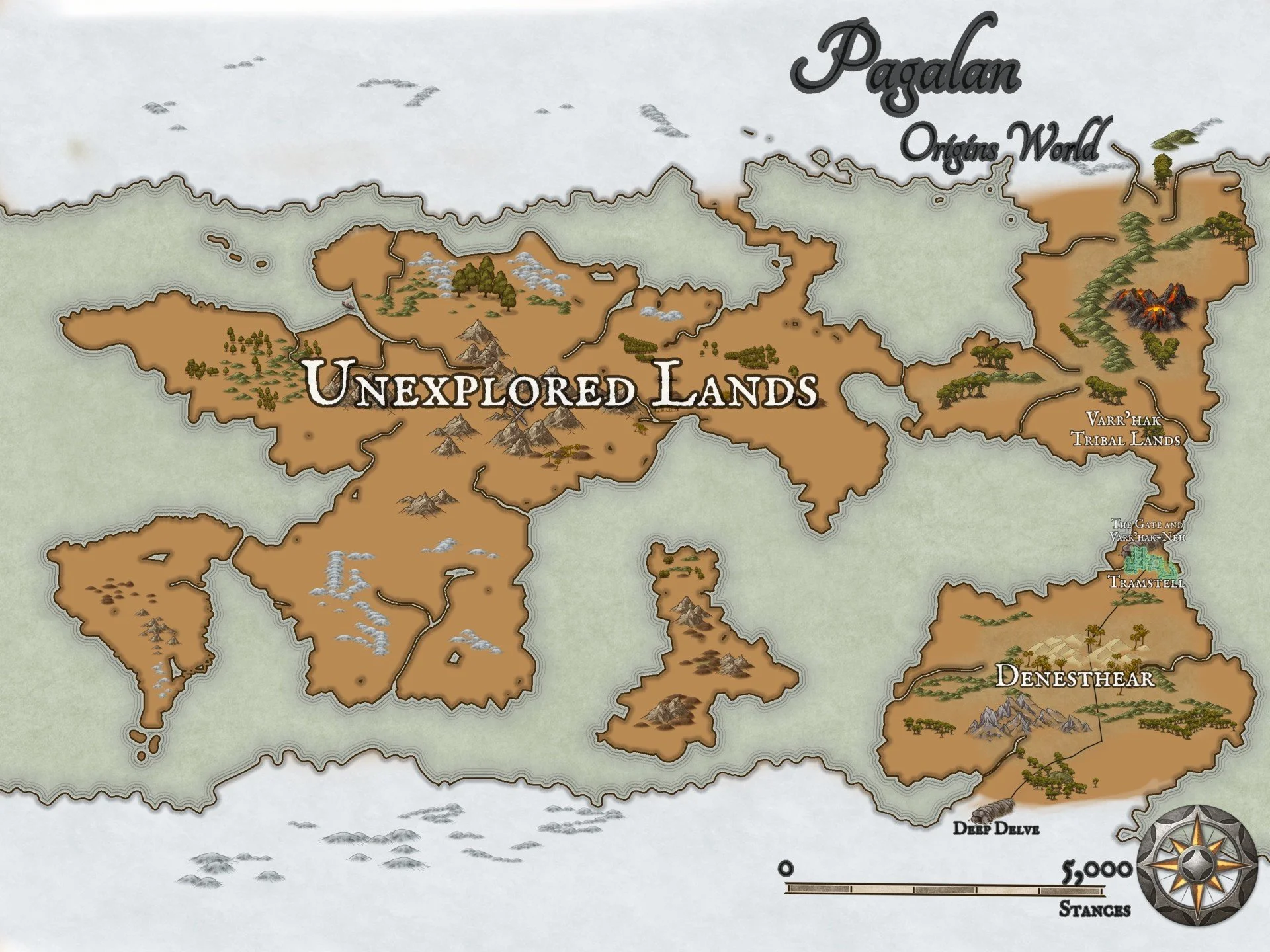
Echoes of Pagalan
Step beyond the pages of The Pagalan Chronicles. Here we share insights into the lore of Pagalan, behind-the-scenes glimpses of writing, and reflections on the craft of fantasy and science fiction.
Ancient Maps vs. Morganuke’s Age: How Pagalan Changed Through the Ages
Pagalan three thousand years before Morganuke’s timeline
One of the most fascinating mysteries in The Pagalan Chronicles lies not only in the people and battles, but in the maps themselves. When Morganuke uncovered ancient Patronese knowledge, he discovered that the Pagalan of his time was not the same world his ancestors first set foot upon.
Pagalan during Morganuke’s timeline
The Ancient Maps of Arrival
When the Patronese first arrived on Pagalan, their maps showed a very different landscape. Vast continents stretched unbroken, coastlines ran smoothly across the seas, and enormous polar ice sheets pressed far into the northern and southern lands. Rivers, mountain ranges, and fertile plains sprawled where now only waves roll.
The Patronese recorded this world with precision, mapping stances of territory and detailing cities that have long since sunk into memory. These ancient charts became not just navigational tools, but a testament to what Pagalan once was before calamity reshaped it.
A World Remade by Catastrophe
By the time of Morganuke Beldere, centuries later, those maps no longer matched reality. Large areas of land had disappeared beneath the sea, swallowed by cataclysmic shifts that tore apart whole regions. Islands stood where continents once stretched. Harbours bustled along jagged coastlines that had once been wide, fertile valleys.
The polar ice sheets had shrunk dramatically, retreating into distant extremes. Their loss exposed new passageways and seas, altering climate and trade, while legends whispered that the melting revealed tunnels and hidden ruins buried since the Patronese first arrival.
Why the Differences Matter
The contrast between these maps is more than geography—it is evidence of the Age of Calamity. Somewhere between the Patronese arrival and Morganuke’s time, Pagalan endured upheavals so immense they reshaped the planet itself. These events, linked to ancient wars and the misuse of portal technology, left scars visible not only in terrain but in memory.
For Morganuke and his allies, the discovery of these differences was more than scholarly curiosity. They pointed to lost homelands, hidden ruins beneath the sea, and the possibility that Denesthear itself lay concealed by the shifting world.
The Legacy of the Maps
Studying these ancient and modern charts side by side reveals Pagalan as a living world of change, mystery, and survival. To hold an old Patronese map is to glimpse a forgotten earth. To walk in Morganuke’s time is to live in the aftermath of a world forever altered.
And within those differences lies the key to understanding not only where the Patronese came from—but where Pagalan’s destiny is still heading.
Pagalan in the Time of Morganuke
When we speak of Pagalan’s long and storied past, few names rise with the same mixture of awe, sorrow, and wonder as Morganuke Beldere. His age was not merely a chapter in history, it was a crossroads where myth and destiny walked hand in hand.
A World at War and in Waiting
Pagalan in Morganuke’s day was a realm divided. Across its seas and fractured lands, the great war with the Cordinens raged, fuelled by treachery and the dark hand of Patronese defectors. Cities like Cryantor, Lobos, and Ventor became battlegrounds, while distant islands such as Banton and Cadmun stood as bastions of resistance. Every community, from the fishing villages to the fortified castles—felt the weight of conflict and the uncertainty of survival.
Yet beyond the clash of swords and the thunder of cavalry, there pulsed something older: the whisper of Denesthear. Long thought a legend, this hidden Patronese homeland, veiled beneath the Nebulee seas, was said to hold truths from an age before the great calamities reshaped Pagalan. For most, it was a tale for dreamers. For Morganuke, it became a destiny he could neither refuse nor fully grasp.
The Burden of Bloodlines
Morganuke was no ordinary island farm boy. Though raised among the simple folk of Banton, he carried within him the blood of House Martilismore, one of Denesthear’s ruling lineages. His silver hair and red eyes marked him as Patronese, but it was his visions, his strange connection to the Nebulee, and the emerald sword that confirmed his place in a greater saga.
In these times, lineage could be a curse as much as a gift. Morganuke longed for peace, for the embrace of Melinor and the laughter of friends. Yet the call of his ancestry demanded more: that he journey across hostile lands, seek lost maps and hidden tunnels, and confront the truth of a civilization splintered between High Orders and rebels.
Allies, Tests, and Betrayals
Pagalan in Morganuke’s age was not a place where any one person could survive alone. He travelled with Melinor, Lengrond, Chanterly, and Calarel, each carrying burdens of their own. He fought beside General Yaloop, Commander Craden Brenadere, and Captain Fraytar, men of iron will but conflicting loyalties. And always, he faced mistrust, Epleon councils branding him heretic, Patronese rulers questioning his worth, and enemies eager to exploit his power.
But it was also a time of resilience. Cities rebuilt after devastation. Armies of once-divided nations formed fragile alliances. Families clung to hope even when the future seemed to crumble into mist.
The Legacy of Morganuke’s Time
What, then, was Pagalan in the time of Morganuke? It was a land of thresholds: between old and new, faith and doubt, exile and belonging. It was an age when the fate of the world rested not in armies alone, but in the choices of a young man torn between the quiet life he yearned for and the impossible destiny thrust upon him.
For readers, revisiting Pagalan in these years is to step into a world both perilous and wondrous. A place where ships like the Aurora braved impossible seas, where hidden tunnels led to forgotten knowledge, and where even in the shadow of betrayal, the bonds of love and friendship glimmered like torches against the dark.
Morganuke’s age reminds us that history is never just about battles won or lost—it is about the people who dared to dream of more, even when the cost of that dream was everything.
Pagalan in the Time of Nigel & Samir: The First Patronese Legacy
Three thousand year before Morganuke was found abandoned as a baby on the Island of Banton, Pagalan stood at a different threshold. It was the age of Nigel Telismore and Samir Camberlain, two names etched into the foundations of Patronese history. Their generation did not inherit stability. Instead, they were the architects of survival, forced to navigate a land where every alliance, every choice, could decide the fate of their people.
The First Arrival
The Patronese did not come to Pagalan quietly. They stepped through the torch-ring with ships, technologies, and hopes that glittered as brightly as their silver hair. Yet to the indigenous tribal peoples, they were strangers, red-eyed interlopers carrying a resonance that stirred the stones themselves. From the first moments, there was suspicion, awe, and the constant threat of misunderstanding turning into war.
Nigel and Samir, distant ancestors to Morganuke, emerged as voices in this uncertain dawn. Nigel was cautious, a steady figure who weighed decisions with care, seeking to hold his people together against internal and external pressures. Samir, though younger, carried a sharper fire, his words often urgent, his visions pressing forward, his conviction that survival meant hard choices.
High Order and Low
It was in their time that the first great schism took root: the division of High Order and Low Order. To preserve what they believed was strength, some councillors decreed that bloodlines mattered, that resonance affinity must be guarded. Nigel’s caution lent weight to restraint, yet Samir pushed hardest for restrictions, convinced it was the only way to keep the Patronese strong.
This decree left scars that would never fully heal. The High Order bore the burden of command, while the Low Order carried resentment in silence. Generations later, that divide still lingered like an old wound beneath Tramstell’s shining walls.
Building Tramstell
Despite their divisions, the Patronese built. Tramstell rose from stone and trellisite, a city shaped by both necessity and vision. Its archive halls began as little more than shelters for memory-stones, yet grew into vast chambers where history itself seemed alive. The city’s gates were sealed, partly in fear, partly in hope that one day they might open on safer terms.
Nigel and Samir walked those streets not as distant ancestors but as men of flesh and struggle, bearing the weight of decisions that would echo for centuries. They brokered uneasy truces with the tribes, sent expeditions across the ridges, and carried the voices of their people into council chambers that often rang with discord.
Why Their Age Still Matters
The time of Nigel and Samir is more than a prologue to the ages and generation that followed It is the crucible where the Patronese identity was forged. Every choice they made, to divide Orders, to seal the gates, to build Tramstell as both fortress and sanctuary, shaped the path of those who came after.
For readers of The Pagalan Chronicles Origins, their story is a reminder that history is not distant. The debates they began would still resonate in the ages to follow. Their words, preserved in crystalline archives, still whisper through the corridors where new generations seek answers.
Nigel and Samir did not see themselves as legends. They were Patronese people trying to balance fear, hope, and survival. Yet their legacy endures, not as relics of the past, but as living voices in the stones of Tramstell.
The Age of Stillness
Tramstell stood unchallenged — a city of white trellisite and light, its towers gleaming against the plains of Denesthear. The resonance grid pulsed beneath its foundations like a sleeping heart. Councillors spoke of order, of hierarchy, of maintaining purity within the High Order, while the Low Order toiled beneath, silent and resentful. To the Council, the age was one of peace. To the world beyond their gates, it was stagnation.
Jason Telismore was born into this stillness, heir to two of the greatest names in Patronese history. Yet he carried neither their ambition nor their pride. Where his father, Councillor Maron Telismore, saw duty and authority, Jason saw confinement — a civilization frozen beneath the weight of its own perfection. He was a scholar of ghosts, drawn not to power but to the voices locked in the archives below Tramstell.
The Weight of Blood
In those archives, Jason uncovered what his ancestors had buried. Records of the first arrivals, of the schism between High and Low Orders, and of the expeditions that had vanished through the gates centuries before. The Council called them lost; Jason called them silenced. The resonance that had once connected the Patronese to their purpose had faded into dogma, its living pulse reduced to myth.
But when Jason touched the old stones — those that still whispered with the energy of the gates — something stirred. The resonance spoke again, faint but undeniable, calling his name across the centuries. “Blood remembers,” it said, and in that moment, Jason realized the past had never been sealed. It had only been waiting.
The Council Divided
The High Council of Tramstell debated endlessly — the Low Orders’ unrest, the growing tremors beneath the city, the rumours of strange lights beyond Denesthear’s border. Some, like Councillor Thyra Camberlain-Dorneth, urged compassion and unity. Others, such as Daelith Corranor and Seliora Veynn, argued for control and purity. Jason’s father stood among them, the unyielding voice of order.
From his seat in the gallery, Jason watched them fracture, their pride blinding them to the truth. The gates beneath Tramstell — once sealed for protection — were stirring again. The resonance was reawakening, and with it, the buried memories of those who had dared to cross centuries before.
The Unfinished Legacy
Jason’s story is not one of conquest, but of return. He sought not to open the gates, but to understand them — to uncover what his ancestors feared. In doing so, he became the bridge between eras: the boy who listened when others spoke, the heir who carried a legacy older than his name.
Pagalan in Jason’s time stood on the edge of rediscovery. To most, it was an age of serenity. To Jason, it was the calm before revelation — the quiet breath before the world remembered its own heartbeat.
The resonance was awake once more.
And through Jason Telismore, it began to speak again.
Pagalan in the Time of Jason Telismore: The Awakening of the Gates
Five hundred years after Nigel Telismore and Samir Camberlain first set foot upon Pagalan’s soil, their world had changed beyond recognition. The wars that once carved borders were now only lines in the archives, and the Patronese had turned their energy inward, perfecting their cities and losing sight of the wild horizons that had once defined them.
Pagalan in the Time of Olivier Martelismore and Tharen Sol Martelismore
The Last Age Before the Silence
Four centuries after Jason Telismore awakened the resonance beneath Tramstell, Pagalan entered its final golden age, a light so bright it could not see its own decay. The Patronese believed their perfection eternal. The towers of Denesthear gleamed white and flawless, their streets paved with living light, their skies ruled by order and symmetry. Yet within those radiant veins, something darker had begun to stir.
This was the world of Olivier Telismore, last heir of the ancient bloodline, and of Tharen Sol Martelismore, the soldier-scholar who would carry the warning no one wished to hear. Together, their names would come to mark the end of the age of control and the dawn of the Age of Silence.
The Illusion of Stability
In Olivier’s time, the Patronese were divided not by enemies but by comfort. The High Order ruled from crystal towers, their lives measured in protocol and precision. The Low Orders worked the conduits and the power veins, their murmurs of unrest dismissed as the noise of lesser minds. Between them lay the pulse of the world itself, the resonance, a power so ancient that few remembered it was alive.
The Council spoke of preservation, not progress. For generations they had forbidden the study of resonance, fearing what their ancestors once wielded. Yet as Olivier soon discovered, the silence beneath Tramstell was not rest. It was waiting.
The Return of the North
Her flight beyond the barrier uncovered a sight that changed the fate of Pagalan forever. In the heart of the northern wastes, beings unlike any human moved among towers of green fire — tall, black-skinned, mirror-eyed entities who worked in silence to reconstruct a gate older than Denesthear itself. The resonance had chosen them now, just as it had once chosen the Patronese. All seemed to be lost, until a timeline shift provide new hope.
Then, strange forges burning blue in the ice, lights crossing the sky where no Patronese craft flew, harmonic pulses felt in the bones of the earth. Olivier’s investigations revealed the truth that history had buried and that the new timeline could not hide: the tribes were not evolving; they were being guided.
The Fall of Denesthear
Only Tharen Sol Martelismore, Olivier’s Great Grandson, student, pudding counsellor and visionary, believed her. The gates of old were awakening beneath the city.
The resonance no longer answered to the Patronese alone. Its voice grew louder with every passing day, echoing through the foundations of Denesthear. Machines began to move without command. Lights flickered green across the white towers. Servitors whispered in languages no one had taught them.
And then the hum began.
It started beneath the archives and spread upward through the grid , the sound of the world remembering its first breath. The Council called it malfunction. Olivier, and then later Tharen, knew better. It was memory.
The Legacy of Olivier and Tharen
Their final act was not of conquest but of preservation. As the resonance surged, threatening to tear Tramstell apart, Olivier entrusted her lineage to Tharen, merging the Telismore and Martelismore names once more, a symbolic uniting of wisdom and courage.
The fall of Denesthear was not an explosion at first, but a slow, radiant undoing. The towers dimmed. The hum deepened into silence. And the world entered an age the later chronicles would call The Great Stillness.
Olivier vanished into the archives, leaving behind her journals for Tharen to later pick up. In those journals was a single phrase etched in the Council vaults:
“Blood remembers. Light forgets.”
A World Awaiting Rebirth
In the centuries that followed, legends would paint Olivier and Tharen as the last guardians of knowledge, those who faced the gates when no one else dared. Pagalan, stripped of its perfection, became a world once more touched by mystery.
The resonance sleeps again, but its pulse endures.






